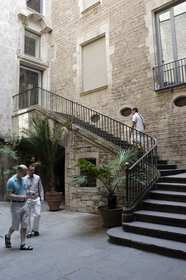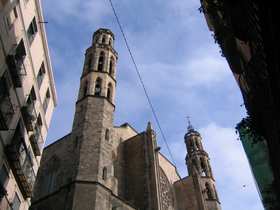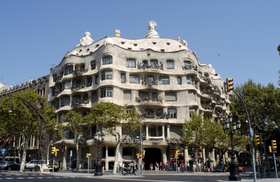Barcelona is the capital of Catalonia and the second largest city in Spain, after Madrid. About five million people live in the Barcelona metropolitan area. It is also Europe's largest metropolis on the Mediterranean Sea. It is the main component of an administrative area of Greater Barcelona, It is located on the Mediterranean coast between the mouths of the rivers Llobregat and Besòs.
Barcelona is today one of the world's leading tourist, economic, trade fair/exhibitions and cultural-sports centres, and its influence in commerce, education, entertainment, media, fashion, science, and the arts all contribute to its status as one of the world's major global cities.
Barcelona is the 16th-most-visited city in the world and the fourth most visited in Europe after Paris, London, and Rome, with several million tourists every year.
Founded as a Roman city, Barcelona became the capital of the County of Barcelona. After merging with the Kingdom of Aragon, Barcelona became one of the most important cities of the Crown of Aragon. Besieged several times during its history, Barcelona has a rich cultural heritage and is today an important cultural centre and a major tourist destination. Particularly renowned are the architectural works of Antoni Gaudí and Lluís Domènech i Montaner, which have been designated UNESCO World Heritage Sites.
The founding of Barcelona is the subject of two different legends. The first attributes the founding of the city to the mythological Hercules 400 years before the building of Rome. The second legend attributes the foundation of the city directly to the historical Carthaginian Hamilcar Barca, father of Hannibal, who named the city Barcino after his family in the 3rd century BC
Barcelona is the passionate capital of Catalonia, an unforgettable city of art, culture and beauty. Gaudi's works, museums, concerts and FC Barcelona’s football team homeland.
A tree-lined pedestrian mall, La Rambla stretches for 1.2 kilometers between Barri Gòtic and El Raval, connecting Plaça de Catalunya in the centre with the Christopher Columbus Monument at Port Vell. La Rambla can be considered a series of shorter streets, each differently named, hence the plural form Les Rambles (the original Catalan form; in Spanish it is Las Ramblas). From the Plaça de Catalunya toward the harbour, the street is successively called the Rambla de Canaletes, the Rambla dels Estudis, the Rambla de Sant Josep, the Rambla dels Caputxins, and the Rambla de Santa Mònica. Construction of the Maremàgnum in the early 1990s resulted in a continuation of La Rambla on a wooden walkway into the harbour called the Rambla de Mar.
Barcelona is the passionate capital of Catalonia, an unforgettable city of art, culture and beauty. Gaudi's works, museums, concerts and FC Barcelona’s football team homeland.
A tree-lined pedestrian mall, La Rambla stretches for 1.2 kilometers between Barri Gòtic and El Raval, connecting Plaça de Catalunya in the centre with the Christopher Columbus Monument at Port Vell. La Rambla can be considered a series of shorter streets, each differently named, hence the plural form Les Rambles (the original Catalan form; in Spanish it is Las Ramblas). From the Plaça de Catalunya toward the harbour, the street is successively called the Rambla de Canaletes, the Rambla dels Estudis, the Rambla de Sant Josep, the Rambla dels Caputxins, and the Rambla de Santa Mònica. Construction of the Maremàgnum in the early 1990s resulted in a continuation of La Rambla on a wooden walkway into the harbour called the Rambla de Mar.
 |
| La Rambla |
Have a sunset drink at a chiringuito bar on the Barceloneta beach, then after dark, join the locals for pub crawling at the Barri Gotic for a huge selection of tapas bars, wine bars, cocktail lounges and even Irish pubs! Now that you've worked up an appetite, head for El Born where you'll find the finest in new catalonian cuisine.
 |
| The Picasso Museum |
The best way to visit the Old Town is on foot, Gothic quarter streets, the old fisherman’s village of Barceloneta and the beach, the fantastic Palau de la Musica Catalana in the Borne district, leading you all the way over to the garden of Barcelona – La Cuitadella . This is a huge part of Barcelona and is a really great way to spend a day.
Barcelona is an extremely practical city in which to go shopping, everything you need is concentrated in the centre and the historical city. Fashion is particularly well represented, by world famous brands which all have a store in Barcelona alongside exciting, young designers. Barcelona is a city well known for interior design and decoration with many stylish outlets in the city, also Barcelona city markets are popular, colorful and noisy places. From food markets to fleas or books markets there is a wide selection throughout the centre on most days.
Nightlife in Barcelona starts around 10pm for bars and midnight for clubs. Bars close around 2am in week days and 3am during the weekend. Clubs will often still be bouncing till dawn breaks.
 |
| Santa Maria del Mar |
Barcelona’s Top 5:
- La Sagrada Familia is the world wide symbol of Barcelona. The monumental church El Temple Expiatori de la Sagrada Família (Expiatory Temple of the Sacred Family) is Gaudi's most famous work and the finest example of his visionary genius. The architect undertook the task in 1883 on the site of a previous neo-Gothic project begun in 1882 by F. del Villar. Gaudi dedicated his life to carrying out this ambitious undertaking which due to his sudden death was left unfinished. Gaudi became obsessed with the church to the point that not only did he focus all of his creative energies into it, but he set up residence in his on-site study as well. On June 7, 1926, Gaudi was hit by a street car while crossing the Gran Vía at Barcelona. Three days later not having regained consciousness, Gaudi died at the age of 74. Work continued on the church, however, until it was interrupted in 1936 when the crypt and Gaudi's study holding his notes and designs were burnt by Spanish Civil War shelling. The project was resumed in 1952 using drawings and scale models as a base although the continuation of the work gave rise to much debate. From 1954 to 1976, the facade and the four towers of the Passion (Western side) were completed.The sculptor Josep. M. Subirachs joined the project team to work on the sculptures on the Portal of Passion in 1987. Today, the constructed part is open to visitors as well as the small Museu del Temple Expiatori de la Sagrada Família with scale models and drawings showing the construction process. The towers can be climbed and offer incredible sights of the city.
- The Picasso museum is "the" museum to visit in Barcelona. For the artist and for the building. Located in Montcada street, in the Gothic area, five medieval palaces linked together to make a museum. Concerning Pablo Ruiz Picasso the museum is indispensable for understanding his formative years. The genius of the young artist is revealed through the more than 3,500 works that make up the permanent collection. It also reveals his relationship with Barcelona: an intimate, solid relationship that was shaped in his adolescence and youth, and continued until his death. To see as well some oils and drawings from Picasso's Barcelona period and even some works from later stages in his career. The Museum also has a set of 42 pieces of ceramics (vases, dishes and plates) made in the 1950s and bequeathed by Jaqueline Picasso in 1982.
- Santa Maria del Mar is a Gothic church from the 14th century, located at the seaside, was built as a private initiative on the wealth accrued from overseas ventures by the inhabitants of La Ribera. The stained glass windows of this basilica, dating from the 15th and 18th centuries, are very famous. From the outside, Santa Maria gives an impression of massive severity that belies the interior. It is hemmed in by the narrow streets of the Ribera, making it difficult to obtain an overall impression, except from the Fossar de les Moreres and the Plaça de Santa Maria, both of them former burial grounds. The latter is dominated by the west end of the church with its rose window. Images of Saint Peter and Saint Paul occupy niches on either side of the west door, and the tympanum shows the Saviour flanked by Our Lady and Saint John. The north-west tower was completed in 1496, but its companion was not finished until 1902.
- The Cathedral of the Holy Cross and Saint Eulalia, also known as Barcelona Cathedral, is the Gothic cathedral and seat of the Archbishop of Barcelona. The cathedral was constructed throughout the 13th to 15th centuries, with the principal work done in the 14th century. The cloister, which encloses the Well of the Geese (Font de les Oques) was completed about 1450. The neo-Gothic façade was constructed over the nondescript exterior that was common to Catalan churches in the 19th century. The roof is notable for its gargoyles, featuring a wide range of animals, both domestic and mythical. The cathedral was constructed over the crypt of a former Visigothic chapel, dedicated to Saint James, which was the proprietary church of the Viscounts of Barcelona, one of whom, Mir Geribert, sold the site to Bishop Guislebert in 1058. Its site faced the Roman forum of Barcelona.
- Casa Milà. After the Sagrada Familia, Casa Milà or "la Pedrera" as it is often called, is probably Gaudi's second most popular building in Barcelona. Casa Milà covers an area of more than 100 square meters and includes two large circular patios, so that almost every part of the house gets its share of sunlight. It is constructed entirely in natural stones, and lacking all the colors and ornamentation design. Maybe one of the most interesting places of the whole complex is the rooftop: here you can find a large ensemble of surrealistic chimneys all looking different and like sculptures standing there alone or in small groups, dominating the rooftop.

Casa Milà or "la Pedrera"



No comments:
Post a Comment